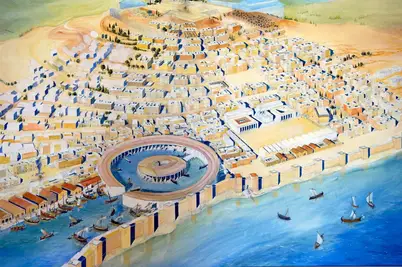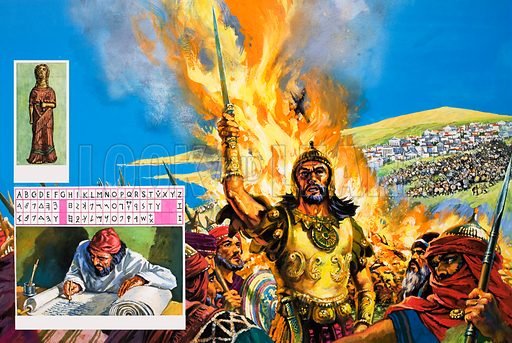The Carthaginian Empire, existing from around 814 to 146 BCE, was one of the ancient world’s most powerful civilizations. Rooted in the city of Carthage in modern-day Tunisia, it thrived on trade and naval prowess, becoming a formidable rival to Rome. Let’s take a journey through the history, culture, and legacy of this remarkable empire.
Founding and Early History
The Mythical Beginnings

Legend has it that Carthage was founded by Queen Dido, who fled from Tyre (in modern-day Lebanon) to escape her brother’s murderous intent. This story, though mythological, underscores Carthage’s Phoenician origins. The Phoenicians were master sailors and traders, and Carthage inherited these skills, positioning itself as a hub of Mediterranean commerce.
A Strategic Location
Carthage’s location on the coast of North Africa was no accident. Nestled in what is now Tunisia, Carthage had access to key trade routes across the Mediterranean. Its harbors, both commercial and military, were marvels of engineering and facilitated its growth into a bustling trade center.
The Rise of a Maritime Empire
Trade and Commerce
Carthage’s prosperity was built on its extensive trade networks. Carthaginian merchants traded goods such as precious metals, textiles, and foodstuffs with various Mediterranean civilizations, including Egypt, Greece, and later Rome. This commerce not only brought wealth but also cultural exchange, making Carthage a cosmopolitan city.
Naval Dominance
The Carthaginian Empire was known for its powerful navy. Carthaginian ships, known as “quinqueremes,” were technological marvels of their time. These ships enabled Carthage to control maritime trade routes and project military power across the Mediterranean. The city’s military port, with its circular design and numerous docks, was unmatched in the ancient world.
Conflicts and Expansion
Sicilian Wars
Carthage’s expansion brought it into conflict with Greek city-states in Sicily. These wars, known as the Sicilian Wars, lasted for centuries and were characterized by fierce naval battles and sieges. Despite many victories, Carthage struggled to maintain control over Sicily, foreshadowing its later conflicts with Rome.
The Punic Wars
The most famous conflicts involving Carthage were the Punic Wars against Rome. These three wars, spanning over a century, were some of the most significant in ancient history.
First Punic War (264–241 BCE)
The First Punic War erupted over control of Sicily. Despite initial successes, Carthage ultimately lost the war and had to cede Sicily to Rome, marking the beginning of its decline in influence.
Second Punic War (218–201 BCE)
The Second Punic War is perhaps the most well-known, thanks to the Carthaginian general Hannibal. His daring crossing of the Alps with war elephants remains legendary. Despite his military genius and several victories on Italian soil, Hannibal could not secure a decisive victory, and Carthage eventually lost again.
Third Punic War (149–146 BCE)
The Third Punic War was a final, brutal conflict. Rome, determined to eliminate Carthage as a threat, besieged the city for three years. In 146 BCE, Carthage was destroyed, its population slaughtered or sold into slavery, and its lands salted to prevent any future habitation.
Carthaginian Society and Culture
Government and Society
Carthage was a republic, with a complex system of governance involving elected officials, a senate, and popular assemblies. The ruling elite, often wealthy merchant families, held significant power. The famous Barcid family, which produced generals like Hannibal, was one such powerful clan.
Religion
Carthaginian religion was heavily influenced by its Phoenician roots. The chief god was Baal Hammon, often depicted with ram’s horns. The city also worshipped Tanit, a goddess of fertility and the moon. Carthaginian religious practices included rituals that some sources claim involved child sacrifice, though this remains a topic of historical debate.
Art and Architecture
Carthaginian art and architecture reflected its multicultural influences. Carthaginian artisans were skilled in metalwork, pottery, and sculpture. The city’s architecture, including its famous double harbor and numerous temples, showcased a blend of Phoenician, Greek, and indigenous African styles.
Legacy of the Carthaginian Empire
Influence on Rome
Despite their bitter conflicts, Carthage significantly influenced Rome. The Romans adopted many Carthaginian technologies, especially in shipbuilding and military tactics. The phrase “Carthago delenda est” (Carthage must be destroyed) by Cato the Elder, highlights how Carthage’s legacy lingered in Roman consciousness.
Archaeological Discoveries
Modern archaeology has uncovered much about Carthaginian life. Sites like Byrsa Hill, the ancient city center, and the Tophet, a religious site, provide insights into Carthaginian society, economy, and religious practices. These discoveries continue to shape our understanding of this ancient civilization.
Cultural Impact
Carthage’s story has permeated literature and popular culture. From Virgil’s “Aeneid” to modern novels and films, the tale of Carthage’s rise and fall continues to captivate audiences. Hannibal’s military campaigns, in particular, have inspired countless military strategists and historians.
FAQs About the Carthaginian Empire
What was the Carthaginian Empire?
The Carthaginian Empire (c. 814–146 BCE) was a powerful ancient civilization centered in Carthage, in modern-day Tunisia. It was known for its maritime trade, naval dominance, and conflicts with Rome.
Who founded Carthage?
According to legend, Carthage was founded by Queen Dido, a Phoenician princess from Tyre, around 814 BCE.
What were the Punic Wars?
The Punic Wars were a series of three wars fought between Carthage and Rome from 264 to 146 BCE. These wars were primarily over control of trade routes and territories in the Mediterranean.
What was unique about Carthaginian society?
Carthaginian society was a blend of various cultural influences, primarily Phoenician. It had a complex political system, a powerful navy, and unique religious practices.
What led to the fall of Carthage?
The fall of Carthage was primarily due to its defeat in the Punic Wars against Rome, culminating in the Third Punic War, where Carthage was destroyed in 146 BCE.
Conclusion
The Carthaginian Empire (c. 814–146 BCE) remains one of the ancient world’s most fascinating civilizations. From its legendary founding to its rise as a maritime power and its epic clashes with Rome, Carthage’s history is a tale of ambition, innovation, and resilience. Despite its ultimate destruction, the legacy of Carthage continues to influence our understanding of ancient history and the dynamics of power, culture, and conflict.

